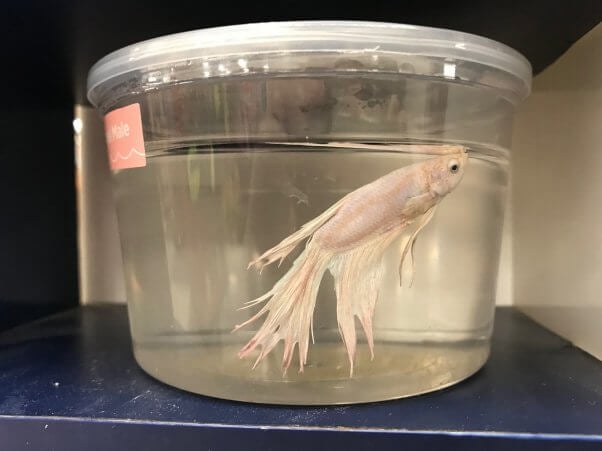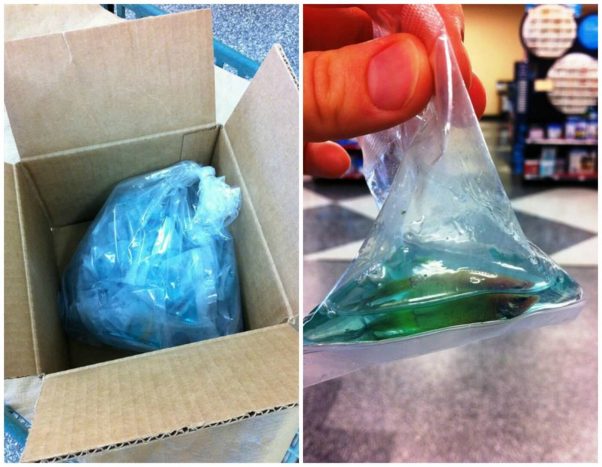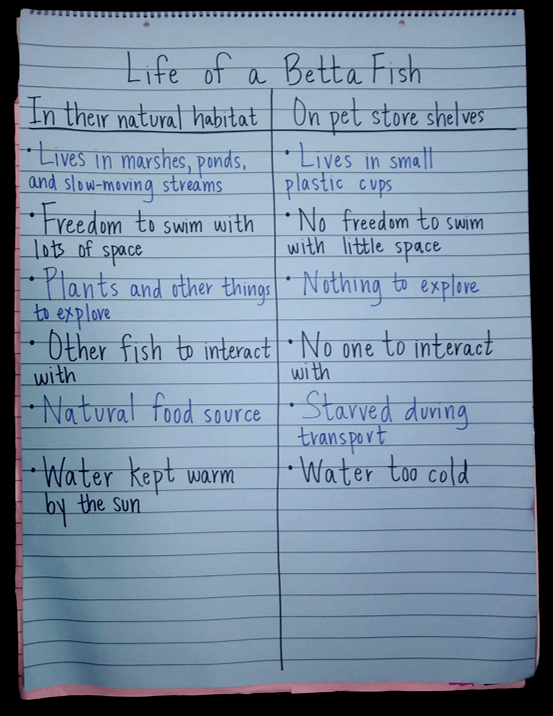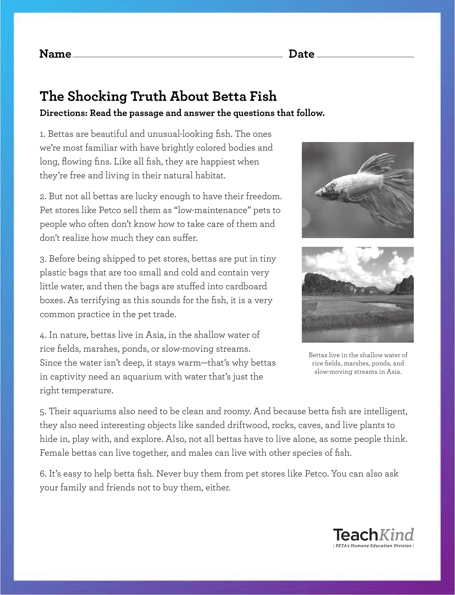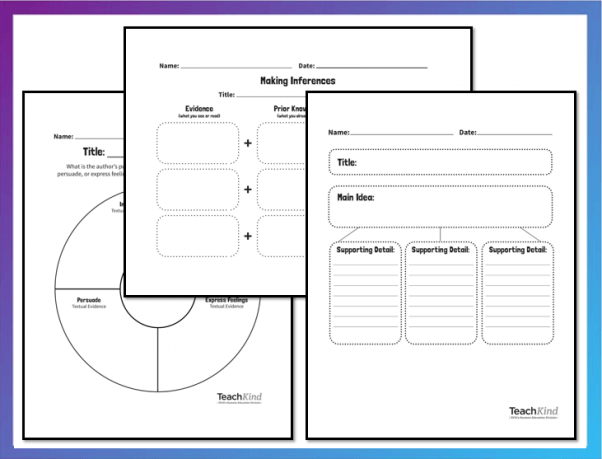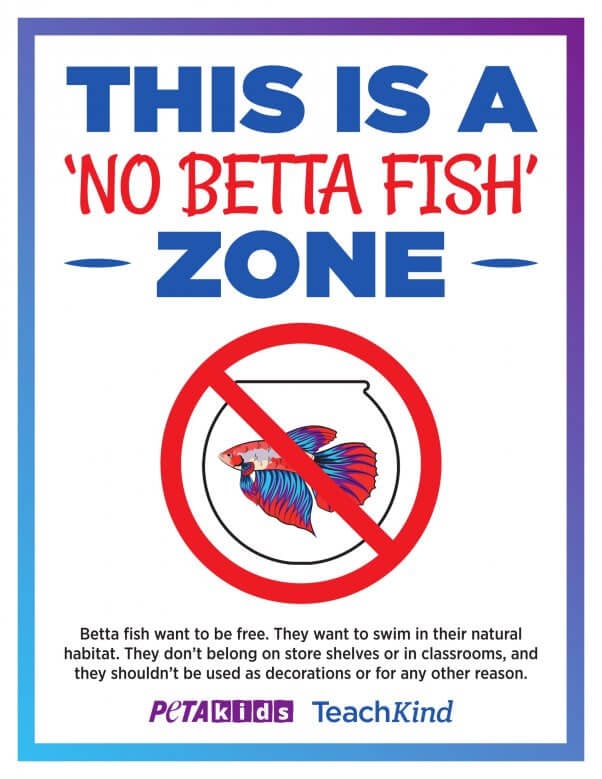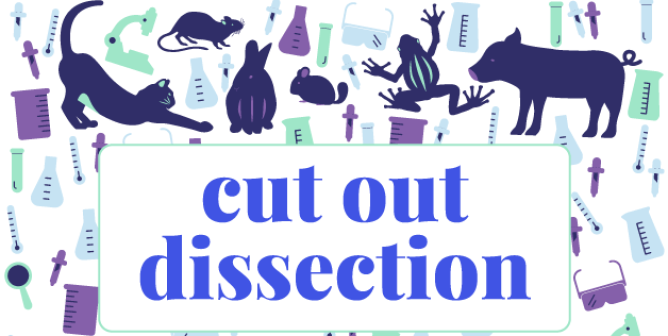Empathy-Building Literacy Centers: Betta Fish Belong in the Wild
This lesson plan is designed to help teachers present animal rights issues to their students. If you’re an educator, please feel free to adapt this material to fit your needs, and contact us if you need help incorporating this activity into your curriculum.
If you’ve ever been to a store that sells animals, you’ve probably seen the miserable conditions in which captive bettas are kept. These vibrant, colorful, and extremely complex fish are confined to cramped plastic cups containing just a couple of inches of water and are often stacked on top of one another and displayed on store shelves.
You can help stop this cruelty. By refusing to buy betta fish—or any other animals—from stores like Petco and by educating your students about the suffering inherent in the pet trade, you’ll be sending companies the loud-and-clear message that consumers like you won’t tolerate such animal abuse. Use this lesson on finding the main idea, determining the author’s purpose, drawing conclusions, and making inferences to convey to students the ideas that betta fish belong in the wild, not on store shelves, and that all living beings—no matter their species—deserve compassion, freedom, and respect.
Suggested grade levels: 3–5
Objectives
Affective: Students will be able to demonstrate an understanding of betta fish as individuals and the reasons why it’s cruel to keep them in captivity and to buy and sell them as pets.
Cognitive: Students will determine the main idea of an informational passage and the author’s purpose for writing, as well as drawing conclusions and making inferences based on contextual evidence.
Background
PETA’s investigations into the pet industry have uncovered appalling neglect of betta fish even before they reach stores. They’re often starved for several days during transport and confined individually to tiny bags stuffed into boxes that are stacked high in massive wholesale warehouses. Many fish die before and during transport to retailers, which can take days, as they’re shipped all over the country. Industry insiders have confirmed that this system is standard practice for some retailers.
Materials
- “The Shocking Truth About Betta Fish” Informational Reading Passage and Test Prep Questions
- Main idea graphic organizer
- Author’s purpose graphic organizer
- Inferencing graphic organizer
- Construction paper and art supplies
Resources
Key Vocabulary
Needs, wants, natural habitat, captivity
Motivation
Have students create a T-chart to compare and contrast the life of betta fish in their natural habitat—the shallow waters of marshes, ponds, and slow-moving streams in Southeast Asia—and that of bettas on a pet store shelf. On Netflix, episode 7 of the Our Planet series has an excellent segment depicting a male betta fish (also known as a Siamese fighting fish) building a nest for his partner using bubbles in their natural habitat. If Netflix isn’t available to you, use the following image to show students the stark differences between bettas’ natural habitat and their living conditions in captivity.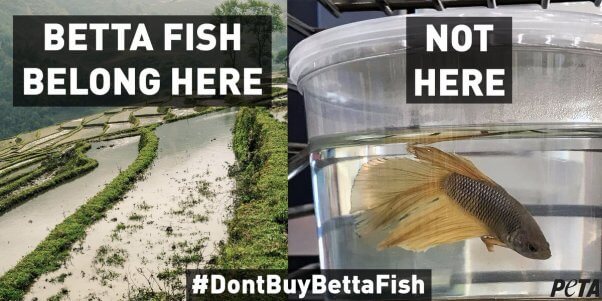
Be sure to discuss betta fish’s basic needs. (Later in this lesson, students will read about their extensive needs and why they shouldn’t be kept as companion animals.) Ask students what all animals need to survive (food, water, shelter, etc.) and then guide the conversation using the following talking points:
- Like all animals, betta fish need their natural food source. Bettas are omnivores, which means that they need to eat both plants and animals. In nature, they eat mostly insects and insect larvae. People who keep bettas as pets sometimes provide them with only plant roots to eat, and while this may keep them alive for a while, they eventually become sick and starve from a lack of proper nutrients.
- Betta fish also require fresh water that’s naturally kept at just the right temperature by the sun. When they’re kept in small plastic cups on pet store shelves or in glass bowls for decorative purposes, their water is often too cold, causing them to suffer.
- In addition to food and water, bettas need safety and freedom of movement. In the wild, they can swim wherever they please, and they enjoy exploring their surroundings. Bettas who are kept in plastic cups barely have enough room to swim in a circle and don’t have plants, rocks, or any other natural features to explore. As a result, they often just float listlessly, with nothing to do.
Show students the animated video below of a captive betta fish “dreaming” of life in the wild. Note that at the 0:35 mark, the video depicts the fish dying. We recommend using your professional judgment when showing it to younger students. Ask students to imagine how they would feel if they were taken from their homes and their families and forced to live in an empty room with no toys, furniture, or anything else for entertainment or comfort. Have students respond in two or three sentences on the back of their T-charts, and then ask a few of them to share their thoughts.
Before Reading
Establish three literacy centers throughout your classroom. If you don’t have the space to create distinct centers, you can also just group students by tables. Designate a “main idea” center, an “author’s purpose” center, and a “drawing conclusions and making inferences” center by leaving a stack of the appropriate graphic organizers at each station. This is a great way for students to practice these skills after you’ve introduced the concepts.
Provide the students with copies of “The Shocking Truth About Betta Fish” Informational Reading Passage and Test Prep Questions, then divide them into three groups, sending each group to a different literacy center. Depending on the size of your class, you might need to have more than one group work on the same task at the same time. Explain that each center has a stack of graphic organizers that students will use to help them answer the corresponding questions in their packet.
Determining the Main Idea
Ask students what they know about determining a text’s main idea (i.e., the central idea that all the details relate to) and key details (i.e., important pieces of information that support the main idea). Identifying the main idea helps students recognize the most important information in the text, which helps them monitor their understanding of it. They can determine the main idea by looking at what the details have in common.
Determining the Author’s Purpose
Tell students that every author has a purpose or reason for writing in a particular way. Hold up an informational text that you’ve read together. Explain that some authors write to inform (i.e., give readers facts about a topic), just as the author of your example text did. Next, hold up a fictional story that you’ve read together. Explain that some authors write to entertain—just as that author did. Say that novels help readers escape into fictional worlds but may also inform them about something at the same time. For example, a fictional story set during a certain period in history may offer facts and information about that time.
Drawing Conclusions and Making Inferences
Discuss with students the fact that we make inferences all the time in order to make decisions about people and situations. Authors expect us to bring our own inferences to their writing. Inferring is a strategy that helps us create a fuller and deeper understanding of the text.
An inference is a new idea that a reader forms by combining clues from a text with what they already know. Making inferences helps us understand ideas and facts that aren’t directly stated. Discuss with students the steps necessary for inferring, such as looking for important textual and visual details (clues) and considering what they already know about the topic (prior knowledge). Tell them to use the clues and their prior knowledge to decide what the author of the work is telling them indirectly.
Show students how to complete each graphic organizer, and use it to determine the answers to the questions. Students can also use the information from their graphic organizers to write paragraphs about the main idea of the passage, the author’s purpose for writing, and conclusions drawn from the passage.
During Reading
As a group, students are to read the passage, complete the graphic organizer, and answer the corresponding questions. For example, those at the center with the “main idea” graphic organizer will answer the main idea questions.
After about 15 to 20 minutes, have students take their packet and completed graphic organizer with them as they rotate to the next literacy center.
After Reading
Reconvene as a class and review the answers to each set of questions. Invite students to share their thoughts about the pet trade, proper animal companion care, or anything else that comes to mind. You can use the following questions to facilitate a discussion:
- Why do you think people buy betta fish? Do you think they realize how much care and attention they require? (Possible answer: People buy betta fish because they’re beautiful and unique looking. They probably believe that they’re easy to take care of and don’t realize how much attention they actually require.)
- Is it fair to bring an animal into your family when you’re unprepared for that responsibility? Why or why not? (Answer: No, it’s not fair. Animals are individuals who require a great deal of care and attention. This costs their guardians time, effort, and money. Before bringing animals into the home, it’s important to research their needs and commit to taking care of them for their entire life.)
- If you have animal companions at home, how do you help take care of them? (Answers will vary.)
- How can people help betta fish who suffer in the pet trade? (Answer: People can refuse to buy betta fish from pet stores like Petco or anywhere else. Instead, they can check their local animal shelter for animals in need of loving permanent homes.)
Real World Connection
As the passage points out, it’s easy to help betta fish and other animals exploited in the pet trade. By simply refusing to buy them from pet stores—and encouraging others to do the same—we can all collectively decrease the overall demand for betta fish, prompting companies that sell them to get out of the business.
Start by making your classroom a designated “no betta fish” zone with TeachKind’s free printable poster. Hang it on your classroom door or in another prominent place to serve as a reminder to your students, colleagues, and anyone else who visits your classroom that bettas belong in their natural habitats, not on store shelves or in classrooms.
Wrap-Up
Celebrate bettas’ fantastic colors and urge others never to buy them from pet stores by having students create persuasive posters depicting these fish where they belong—in their natural habitat. Posters should include a title as well as information from the passage about bettas and their natural habitats, their needs, and why buying them from pet stores is cruel.
Point out that these amazing animals appear in a wide range of colors, just like humans, but that the brightly colored captive-bred betta fish sold by retailers such as Petco look very different from their wild counterparts because they were deliberately bred to look that way in order to attract buyers.
Have students answer the following questions on the back of their posters:
- What is the main idea of your poster?
- What is your purpose for creating this poster?
- What conclusion(s) will someone come to after seeing your poster?
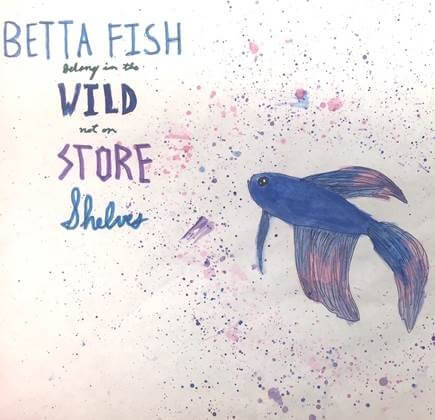
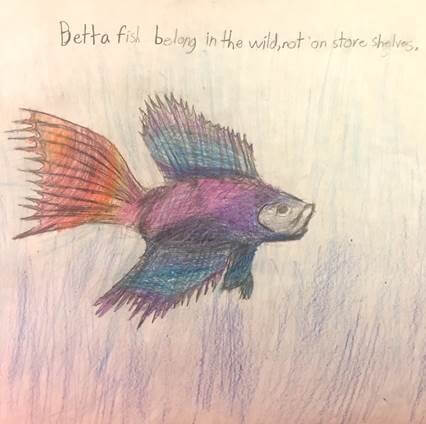
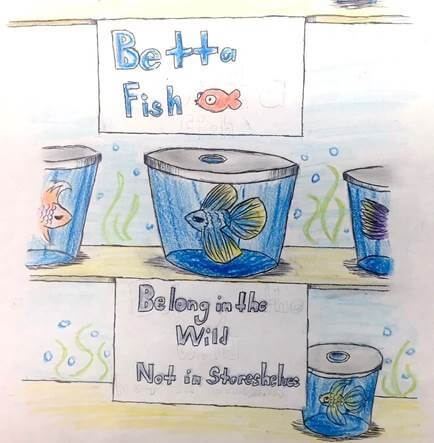 Assessment
Assessment
Evaluate students’ T-charts, graphic organizers, and reading comprehension responses for contextual evidence. Evaluate posters for concepts of life in the wild and persuasive writing techniques.
Common Misconception
The following are myths about betta fish: They’re easy “starter pets” who can teach children responsibility and kindness to animals, and they’re unintelligent and lack the capacity to feel pain or suffer.
Reality
Bettas and other fish have extensive needs. In fact, some goldfish can live up to 30 years, so in some respects, they present an even greater commitment than a dog or a cat, as these animals only live to be 12 to 15 years old, on average. While fish may not be as familiar to us as other animals with whom people share their homes, they still deserve our protection. Fish are highly intelligent animals whose pain response is comparable to that of mammals. They use tools and enjoy complex social lives.
Remind students that they can appreciate the splendor of betta fish without contributing to their exploitation. By making use of online resources, nature documentaries, and books available in libraries, everyone can admire their beauty. Students can help them by never purchasing them from stores like Petco.
Extension
- Science: When studying animal traits, habitats, structure and function, and ecosystems, discuss the ways in which a betta’s life in captivity can’t possibly mimic a life in nature.
- Social Studies: When studying the geographic region of Southeast Asia (where betta fish live in their natural habitat), have students measure the distance that a betta must be transported in order to be sold in stores in the U.S.
Common Core Learning Standards Addressed
CCSS.ELA-LITERACY.RI.3.1
Ask and answer questions to demonstrate understanding of a text, referring explicitly to the text as the basis for the answers.
CCSS.ELA-LITERACY.RI.3.2
Determine the main idea of a text; recount the key details and explain how they support the main idea.
CCSS.ELA-LITERACY.RI.4.1
Refer to details and examples in a text when explaining what the text says explicitly and when drawing inferences from the text.
CCSS.ELA-LITERACY.RI.4.2
Determine the main idea of a text and explain how it is supported by key details; summarize the text.
CCSS.ELA-LITERACY.RI.5.2
Determine two or more main ideas of a text and explain how they are supported by key details; summarize the text.
Need more inspiration? Sign up for TeachKind News to stay up to date with new content and promotions.
By submitting this form, you’re acknowledging that you have read and agree to our privacy policy and agree to receive e-mails from us.

